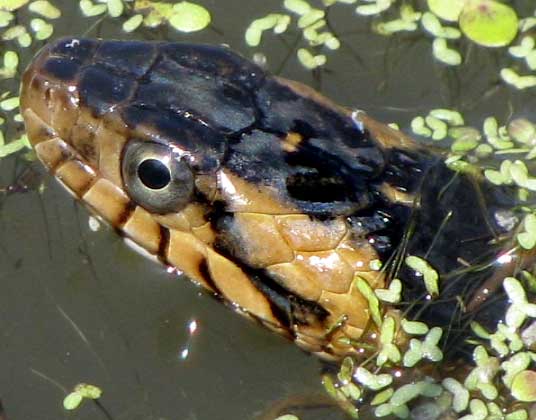Excerpts from Jim Conrad's
Naturalist Newsletter

from the March 30, 2009 Newsletter, issued from the forest near Natchez, Mississippi; elevation ~400ft (120m), ~N31.47°, ~W91.29°:
A BROAD-BANDED WATER SNAKE SUNNING
Karen is an exceptional snake spotter so the other day when I came in from hiking down a levee in St. Catharine NWR I wasn't surprised that she had a pretty one waiting for me, stretched out atop a windrowed heap of duckweed at the water's edge as seen above.
In that picture note the bulge at mid body, which probably is a frog meal being digested. The snake is a Broad-banded Water Snake, NERODIA FASCIATA CONFLUENS, whose favorite foods are listed as frogs, tadpoles and fish, in that order. This individual was a small one, about two feet long. A head close-up is below:

The field guide says that this species is often killed by people thinking it's a venomous Cottonmouth, but you can see in the above picture that the snake's pupil is round, while in all pit-vipers (Cottonmouths, rattlesnakes, copperheads... ) the pupil is elliptic, or "cat-eyed," plus there's no pit between the eye and nostril, which all pit-vipers have.
The individual in the picture was very accommodating, staying still as we took pictures. When I got too close, like lightning he dove into the duckweed carpet completely disappearing, but quickly poked his head up again at the carpet's edge. One reason he may have afforded such a close look is that in Nature such stark banding often is interpreted as warning patterning, as among bees, plus the species itself has a reputation for very vigorously defending itself if fooled with, so it might "want" a distinctive appearance.
This snake's taxonomy has shifted a lot during recent years. Currently the species N. fasciata is regarded as the "Southern Water Snake" but each of its three subspecies, of which our ssp. confluens is one, bears its own English Name, N.f. confluens's being "Broad- banded Water Snake." Some experts lump subspecies of N. clarkii here, which also have their own names.